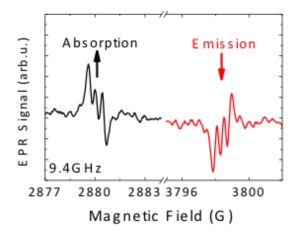Members
Jean-Louis Cantin, Benoît Eble, Sophie Hameau, Florent Margaillan, Jurgen von Bardeleben
Quantum information processing is based on the superposition and entanglement of states of a quantum bit or qubit.
It has recently been shown that certain point defects in solids can constitute such qubits. Indeed, due to the reorganization of the electronic pattern in their environment, these defects have in general a non-zero electronic magnetic moment (spin). This spin is quantized and its state can be manipulated optically for example. This has already been successfully achieved in the particular case of a diamond defect called NV center. This defect has a spin S=1 which can be manipulated by means of microwave pulses and read optically because it presents a perfectly stable luminescence at room temperature and thus constitutes a convenient single photon source for quantum cryptography applications for example.
At INSP, we managed to identify a similar defect in silicon carbide (SiC), a semiconductor which, unlike diamond, is mastered by the microelectronics industry and is mature for the envisaged applications. This defect is also called ‘NV center’ because it is composed of a silicon gap (vacancy) associated with a nitrogen atom (nitrogen being a dopant of SiC). Another decisive advantage is that SiC crystallizes in different structures in which the NV center adopts several configurations, all spectrally distinct. It is therefore possible to selectively address a subset of qubits within the same crystal. We have been able to determine by electron paramagnetic resonance (EPR) under optical excitation the magneto-optical properties of each of the configurations in several SiC polytypes and the experimental results have been confronted with theoretical calculations carried out in collaboration with the University of Paderborn (Germany) in order to establish the atomistic structure. Advanced studies of the optical properties of these defects are currently in progress at INSP, in particular photo-luminescence experiments in the 1µm-1.5µm infrared (Telecom band). The short term objective is the optical detection of magnetic resonance (ODMR) which will allow to validate the relevance of other defects of SiC for applications in quantum information processing.

Figure 1: In red: representation of the electron spin density (paramagnetic electron) around the NV center in 4H-SiC (seen along the c axis ([0001]) of the crystal).

Figure 2: (a): EPR spectrum obtained at 4K in X-band under laser excitation at 2.4eV.

Figure 3: (b) : energy diagram representing the Zeeman sub-levels of the NV defect (S=1) as a function of the applied magnetic field.
Collaborations
- Lehrstuhl für Theoretische Physik, Universität Paderborn, Germany
- The Photonics Institute and Centre for Disruptive Photonic Technologies, Nanyang Technological University (NTU), Singapore
Funding
- Project MERLION with NTU Singapore (2016-2018)
Publications
- Kh. Khazen, H. J. von Bardeleben, S. A. Zargaleh, J. L. Cantin, Mu Zhao, Weibo Gao, T. Biktagirov, and U. Gerstmann. High-resolution resonant excitation of NV centers in 6H−SiC: A matrix for quantum technology applications.Phys. Rev. B 100, 205202 (2019) https://journals.aps.org/prb/abstract/10.1103/PhysRevB.100.205202
- H. J. von Bardeleben, S. A. Zargaleh, J. L. Cantin, W. B. Gao, T. Biktagirov, and U. Gerstmann. Transition metal qubits in 4H-silicon carbide: A correlated EPR and DFT study of the spin S=1 vanadium V3+ center. Phys. Rev. Materials 3, 124605 (2019) https://journals.aps.org/prmaterials/abstract/10.1103/PhysRevMaterials.3.124605
- Mu, Z Zargaleh, SA von Bardeleben, HJ Fröch, JE Nonahal, M Cai, H Yang, X Yang, J Li, X Aharonovich, I Gao, W. Coherent manipulation with resonant excitation and single emitter creation of nitrogen vacancy centers in 4H silicon carbide. Nano letters 20 (8), 6142-6147 (2020)
- R. Ben Aich, S. Ben Radhia, K. Boujdaria, M. Chamarro, C. Testelin. Multiband k·p Model for Tetragonal Crystals: Application to Hybrid Halide Perovskite Nanocrystals. Journal of Physical Chemistry Letters, American Chemical Society, 2020, pp.808-817. ⟨10.1021/acs.jpclett.9b02179⟩. ⟨hal-02454958⟩
- Michal Baranowski, Paulina Plochocka, Rui Su, Laurent Legrand, Thierry Barisien, Frederick Bernardot, Qihura Xiong, Christophe Testelin, and Maria Chamarro. Exciton binding energy and effective mass of CsPbCl3: a magneto-optical study. Photonics Research 8 (10), A50-A55 (2020) https://doi.org/10.1364/PRJ.401872
- Kh. Khazen, H. J. von Bardeleben, S. A. Zargaleh, J. L. Cantin, Mu Zhao, Weibo Gao, T. Biktagirov, and U. Gerstmann. High-resolution resonant excitation of NV centers in 6H-SiC : A matrix for quantum technology applications. Physical Review B 100 p205202 (2019). https://journals.aps.org/prb/abstract/10.1103/PhysRevB.100.205202
- S. Zargaleh, H. von Bardeleben, J. Cantin, U. Gerstmann, S. Hameau, et al.. Electron paramagnetic resonance tagged High Resolution Excitation Spectroscopy of NV-Centers in 4H-SiC. Physical Review B: Condensed Matter and Materials Physics (1998-2015), American Physical Society, 2018, 98 (21), pp.214113. ⟨10.1103/PhysRevB.98.214113⟩. ⟨hal-02298324⟩
- S. A. Zargaleh, S. Hameau, B. Eble, F. Margaillan, H. J. von Bardeleben, J. L. Cantin, and Weibo Gao. Nitrogen vacancy center in cubic silicon carbide : A promising qubit in the 1.5 mu m spectral range for photonic quantum networks. Physical Review B 98 p165203 (2018). https://journals.aps.org/prb/abstract/10.1103/PhysRevB.98.165203

